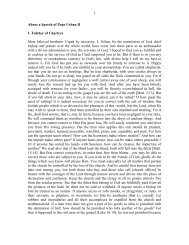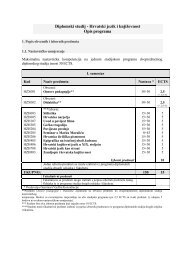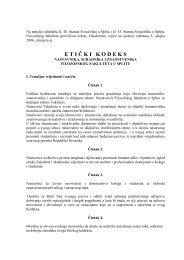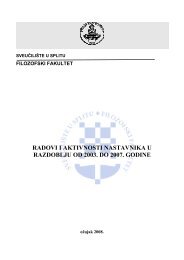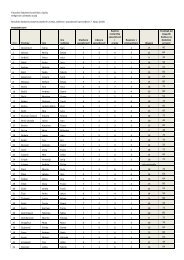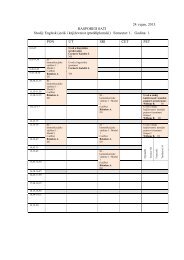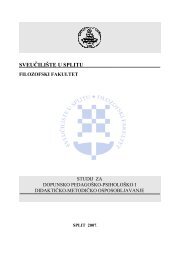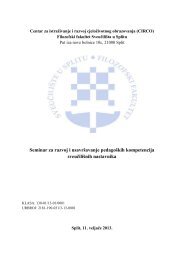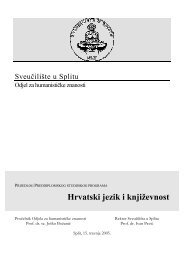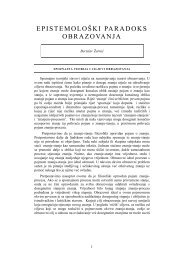English Studies
English Studies
English Studies
Create successful ePaper yourself
Turn your PDF publications into a flip-book with our unique Google optimized e-Paper software.
G R A D U A T E D E G R E E P R O G R A M M E : E N G L I S H S T U D I E S<br />
Year of study Second Semester Three<br />
ECTS<br />
(Number of<br />
credits allocated)<br />
Name of<br />
lecturer<br />
Learning<br />
outcomes and<br />
competences<br />
3 ECTS<br />
Contact hours (25 seminars + 5 advisory hours) = 0.75 credits.<br />
Student study time (67.5 hours) = 2.25 credits.<br />
Jurica Pavičić, MA, Senior Lecturer<br />
Brian Willems, Assistant<br />
After the completion of the course, the student will have developed and<br />
applied an in-depth understanding of key concepts and theoretical and<br />
practical approaches to cinematic adaptations of a wide variety of literary<br />
sources. This will have been done through a thorough analysis of both text<br />
and film via a number of contemporary thinkers in film and other<br />
disciplines.<br />
Prerequisites The student should have previously completed a course of Introduction to<br />
Literary <strong>Studies</strong> or an equivalent course.<br />
Course contents Students will work through an in-depth understanding of such key concepts<br />
of literary adaptation as fidelity, implied author, off-screen space, the voice,<br />
narrative presence, enunciation, cinematic codes and subcodes, and timelapse.<br />
These will be applied through a close reading of both the literary<br />
source and cinematic adaptation(s). Students will approach the field of<br />
adaptation via such thinkers as Michel Chion, Gilles Deleuze, Slavoj Žižek,<br />
James Monoco and others.<br />
The cinematic adaptations of the following literary texts are likely to be<br />
discussed:<br />
Shakespeare, Hamlet; J. Austen, Pride and Prejudice; J. Conrad, Heart of<br />
Darkness; G. Greene, The Quiet American; V. Nabokov, Lolita; H.<br />
Recommended<br />
reading<br />
Supplementary<br />
reading<br />
Kureishi, My Beautiful Laundrette; C. Palahniuk, Fight Club.<br />
Palahniuk, C. (1996). Fight Club. New York, W.W. Norton & Co.<br />
Mann, T. (1998). Death in Venice and other tales. New York, Viking.<br />
Brontë, E. (2003). Wuthering Heights: the 1847 text, backgrounds and<br />
contexts, criticism. A Norton critical edition. New York, Norton.<br />
Nabokov, V. (1991). The Annotated Lolita. New York, Vintage Books.<br />
Clowes, D. (2008). Ghost World. Seattle, Fantagraphics Books.<br />
Winterson, J. (1987). Oranges are not the only fruit. New York, Atlantic<br />
Monthly Press.<br />
Campbell, J. W. (1976). Who Goes There?: Seven Tales of Science-fiction.<br />
Westport, Hyperion Press.<br />
Potocki, J. (1996). The manuscript found in Saragossa. London, Penguin.<br />
Script<br />
Chion, M. (1999). The Voice in Cinema. New York: Columbia University<br />
Press.<br />
Manovich, L. (2002). The Language of New Media. Cambridge: MIT Press.<br />
McFarlan, B. (1996). Novel to Film: An Introduction to the Theory of<br />
43



